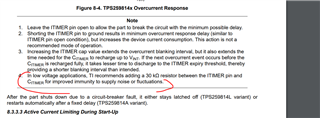I am checking the overcurrent protection operation of my prototype board with TPS259814A.
After the overcurrent protection works, the TPS259814A automatically returns to steady state when the load is removed.
However, after that, OUT does not turn off even if EN is set to 0V.
After setting IN to 0V and then supplying power again, OUT can be controlled by EN.
Is this behavior in accordance with the specifications?
Because of the Thanksgiving holiday in the U.S., TI E2E™ design support forum responses may be delayed from November 25 through December 2. Thank you for your patience.
-
Ask a related question
What is a related question?A related question is a question created from another question. When the related question is created, it will be automatically linked to the original question.




 ,
,


